Conversational analytics is an innovative approach that leverages advanced technologies to analyze and derive insights from customer conversations.
By tapping into the vast amount of data generated through various customer communication channels, you can deeply understand your customers’ needs, preferences, and pain points. This article explores the intricacies of conversational analytics, including its working mechanisms, analysis techniques, and the tools available to harness valuable insights.
Key Takeaways
Conversational Analytics: Using Insights to Enhance Customer Experience
In a world where data is the new gold, businesses continuously seek innovative ways to leverage this valuable resource. One such way is through conversational analytics — a powerful tool that provides deep insights into customer interactions across various communication channels. We will dive into the immense potential of conversational analytics, discussing how it can help businesses understand customer behavior, enhance customer service, and tailor marketing strategies for improved outcomes.

Conversational analytics allows you to leverage insights from customer interactions to enhance the overall customer experience. By analyzing data from various communication channels such as phone calls, emails, and chat conversations, you can extract valuable insights to improve products, services, and processes.
These insights can help you identify customer pain points, preferences, and expectations, allowing you to tailor your offerings accordingly. Additionally, it can provide valuable conversation intelligence, enabling you to pinpoint trends, patterns, and sentiments in customer conversations.
You can use this information to optimize customer service, personalize your marketing messages, and enhance customer satisfaction. By leveraging conversational analytics to its full potential, you can gain a competitive edge by understanding and meeting the needs of your customers more effectively.
What Actually is Conversational Analytics?
Frequently, businesses employ conversational analytics to analyze customer interactions and extract valuable insights for enhancing their overall operations. You can identify patterns, trends, and customer preferences by analyzing these conversations, allowing you to make data-driven decisions that lead to sustainable growth.
Conversational analytics analyzes conversational data, such as customer interactions through voice calls, chatbots, or social media platforms, to gain insight into customer experience and sentiment.
How Does Conversational Analytics Work?
Examining the underlying technology and methodologies that extract insights from customer conversations is essential to understanding conversational analytics. Conversational analytics utilizes advanced techniques such as natural language processing (NLP) and artificial intelligence (AI) to analyze customer conversations in real-time.

As a thought-provoking portal into your customer communications, conversational analytics tirelessly gather abundant data from various sources. These sources span voice calls, chat logs, and countless social media engagements. Here are three critical elements of how conversational analytics function:
- Data collection
Conversational analytics platforms gather data from various sources, including voice calls, chat transcripts, and social media interactions. - Language understanding
NLP algorithms enable the system to understand and interpret the meaning of customer conversations, including sentiment analysis and intent recognition. - Insights generation
Through AI algorithms, conversational analytics extracts valuable insights into customer preferences, behaviors, and needs.
By leveraging these technologies, conversational analytics provides actionable insights into customer conversations. Now, let’s delve into the next section to explore how to analyze these conversations in more detail.
Analyzing Customer Conversations
Analyzing customer conversations involves extracting insights and patterns from the data collected. This analysis provides a comprehensive understanding of customer sentiment, allowing you to identify areas for improvement and develop strategies to enhance customer satisfaction.
Analyzing customer conversations offers a wealth of information, such as recurring issues, common questions, and areas where customers may get stuck in the sales or support process. By understanding these pain points, you can make targeted improvements to products, services, or operations, ultimately leading to an elevated customer journey and loyalty.
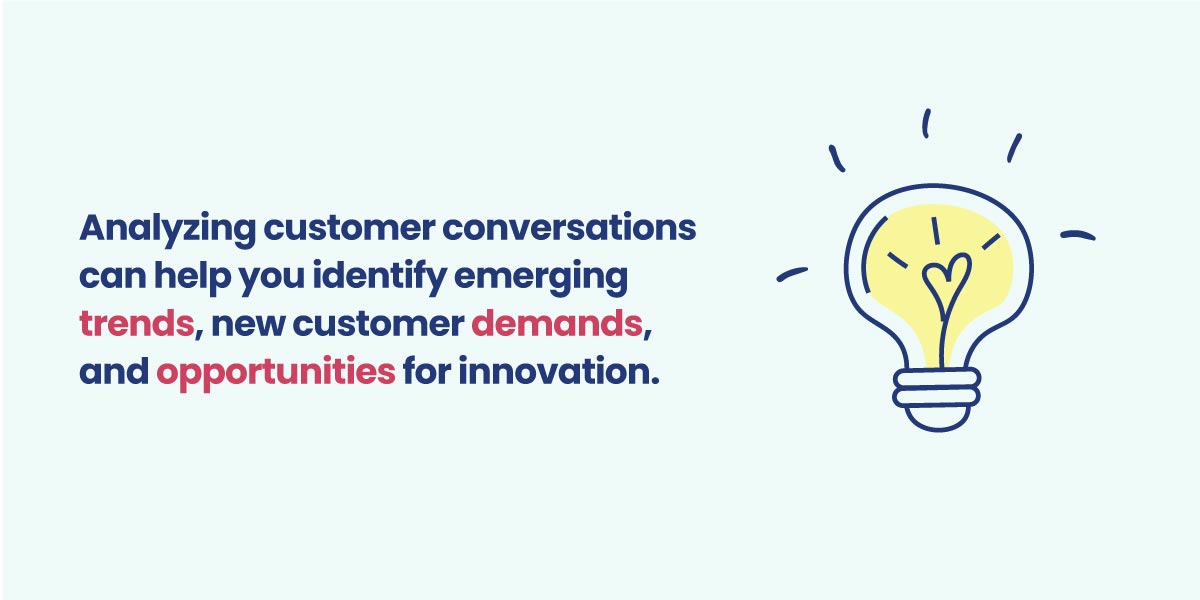
Additionally, analyzing customer conversations can help you identify emerging trends, new customer demands, and opportunities for innovation. You can proactively adapt your strategies and offerings to meet evolving customer needs and preferences by staying on top of customer conversations.
Utilizing Analytics Tools for Insights
With the rising importance of data-driven decision-making in today’s dynamic business landscape, organizations increasingly leverage powerful analytics tools to inform their decision-making process and fuel strategic initiatives to drive growth and optimize performance. Here are three ways in which these analytics tools can provide actionable insights:
- Sentiment Analysis
Businesses can identify patterns and trends in customer satisfaction or dissatisfaction by analyzing the tone and sentiment of customer conversations. This helps you drill deeper into your interactions with customers to understand how they feel when they engage with your brand. - Topic Modeling
Analytics tools can identify the main topics discussed in customer conversations. This helps to understand the key issues or concerns customers raise and take appropriate actions to address them. - Customer Journey Analysis
By analyzing the entire customer conversation journey, you can identify bottlenecks or areas of improvement to optimize processes and provide a seamless customer experience.
Applying AI and Machine Learning
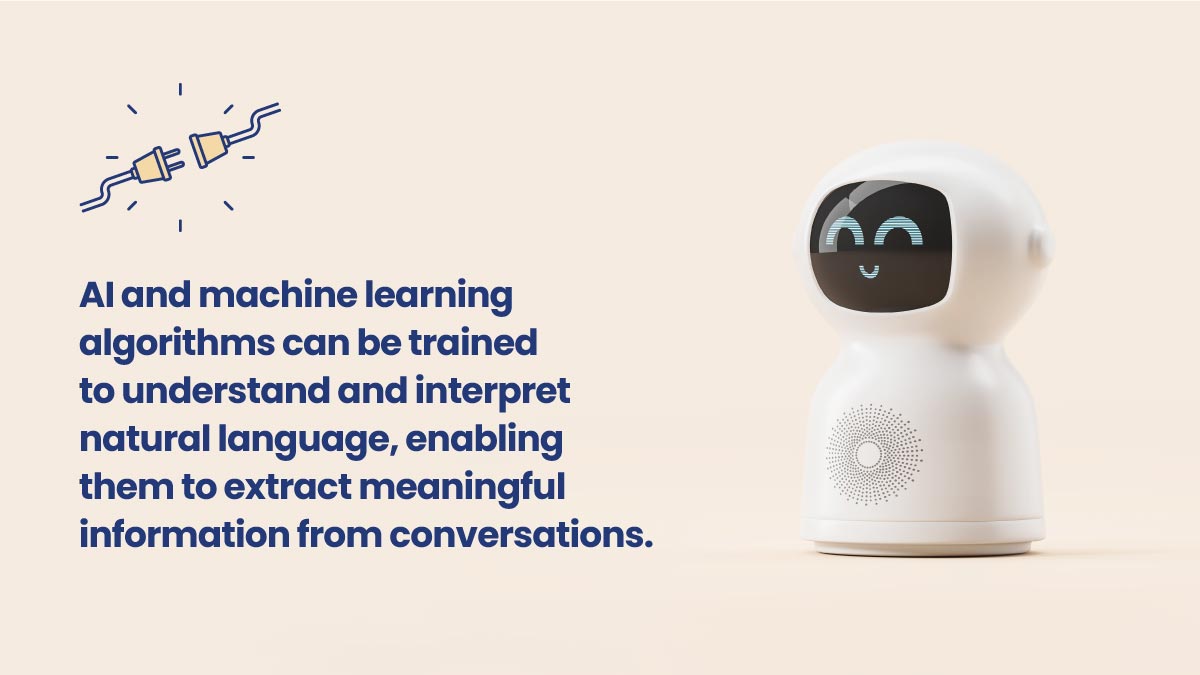
Applying AI and machine learning techniques can further enhance the accuracy and efficiency of conversational data analysis. AI and machine learning algorithms can be trained to understand and interpret natural language, enabling them to extract meaningful information from conversations.
By analyzing patterns and trends in conversations, these techniques can provide valuable insights into customer behavior, preferences, and sentiment. Conversational analytics powered by AI and machine learning can also improve the accuracy of sentiment analysis, allowing you to understand satisfaction levels and identify areas for improvement contextually.
Furthermore, AI and machine learning can automate the process of conversational analysis, saving you time and resources. Integrating AI and machine learning into conversational analysis can significantly enhance its capabilities and provide you with deeper, more accurate customer intelligence.
Benefits of Conversational Analytics
Conversational analytics has revolutionized how businesses connect with their customers, offering many advantages that propel companies toward success. Here are three key benefits businesses can harness from this technological innovation: actionable insights, enhanced customer experience, and improved operational efficiency. Let’s explore these compelling advantages to understand how they can drive your business forward.
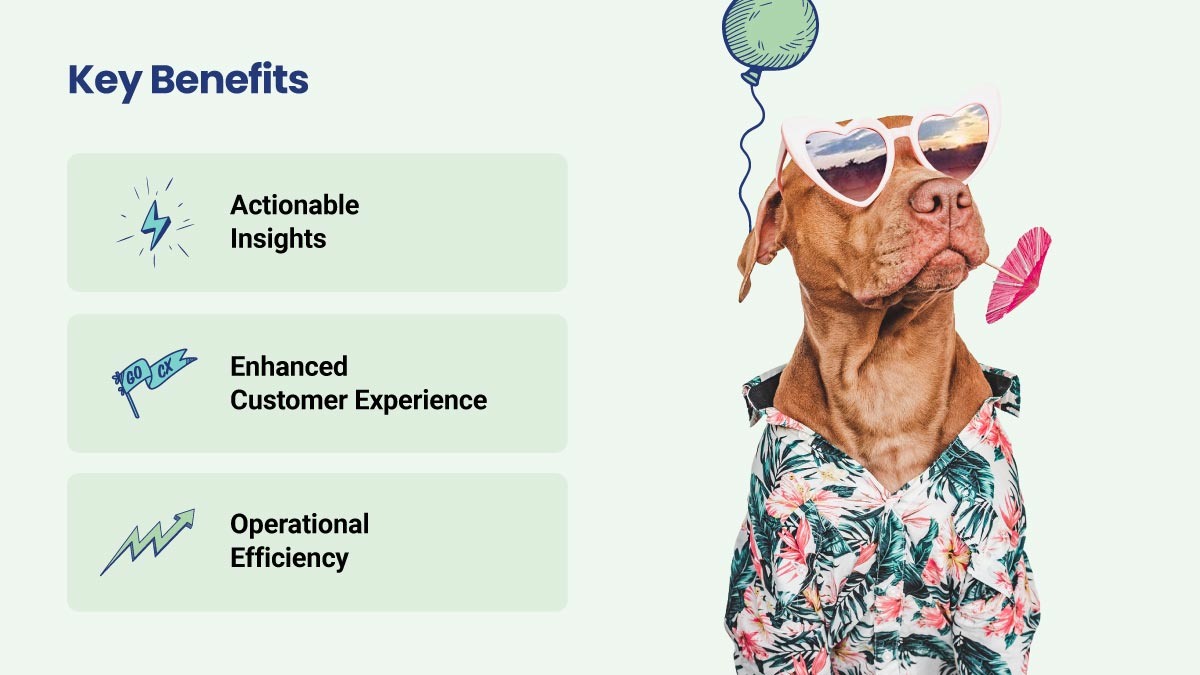
- Actionable insights
Conversational analytics gives businesses deep insights into customer interactions, allowing them to identify trends, patterns, and preferences. This helps to optimize marketing strategies, improve product offerings, and enhance customer service. - Enhanced customer experience
By analyzing customer conversations, you can better understand customer needs, pain points, and preferences. You can use this information to personalize interactions, provide more relevant recommendations, and deliver a seamless and tailored customer experience. - Operational efficiency
Conversational analytics can help identify inefficiencies in customer support processes, enabling operations streamlining and resource allocation improvement. By analyzing conversation data, you can identify areas for improvement, automate repetitive tasks, and enhance overall operational efficiency.
Enhancing Customer Experience
One key aspect of enhancing the customer experience is personalizing customer interactions. In fact, 76% of customers expect personalization. Conversational analytics can significantly contribute to achieving this goal, specifically through an informal analytics tool.
You can gain valuable insights into customer sentiment by analyzing real-time conversations and adjusting your approach accordingly. This could mean that you use the customers’ preferred communication channel or provide recommendations based on historical data such as purchase history, etc. This proactive approach not only improves customer satisfaction but also helps in building long-term relationships.

Identifying Brand Insights
By meticulously examining and interpreting conversational data, you have the opportunity to unearth a treasure trove of brand insights, which can provide a valuable foundation for shaping your marketing strategies, fine-tuning your customer approach, and ultimately bolstering the power and appeal of your brand.
Three Critical ways in Which Conversational Analytics Helps in Identifying Brand Insights
- Understanding customer sentiment
You can gain insights into customer perceptions, preferences, and emotions toward their brand by analyzing customer conversations. This information can be used to identify areas where the brand is excelling and areas that require attention. - Identifying emerging trends
Conversational analytics allows you to stay ahead of the curve by identifying emerging trends and topics of interest among your target audience. This insight can inform marketing strategies and help companies align their brand messaging with customer expectations. - Leveraging customer feedback
Conversational data is a valuable source of customer feedback. Businesses can gain insights into customer pain points, suggestions, and overall satisfaction levels by analyzing customer conversations. This feedback can enhance the brand experience and improve customer retention.
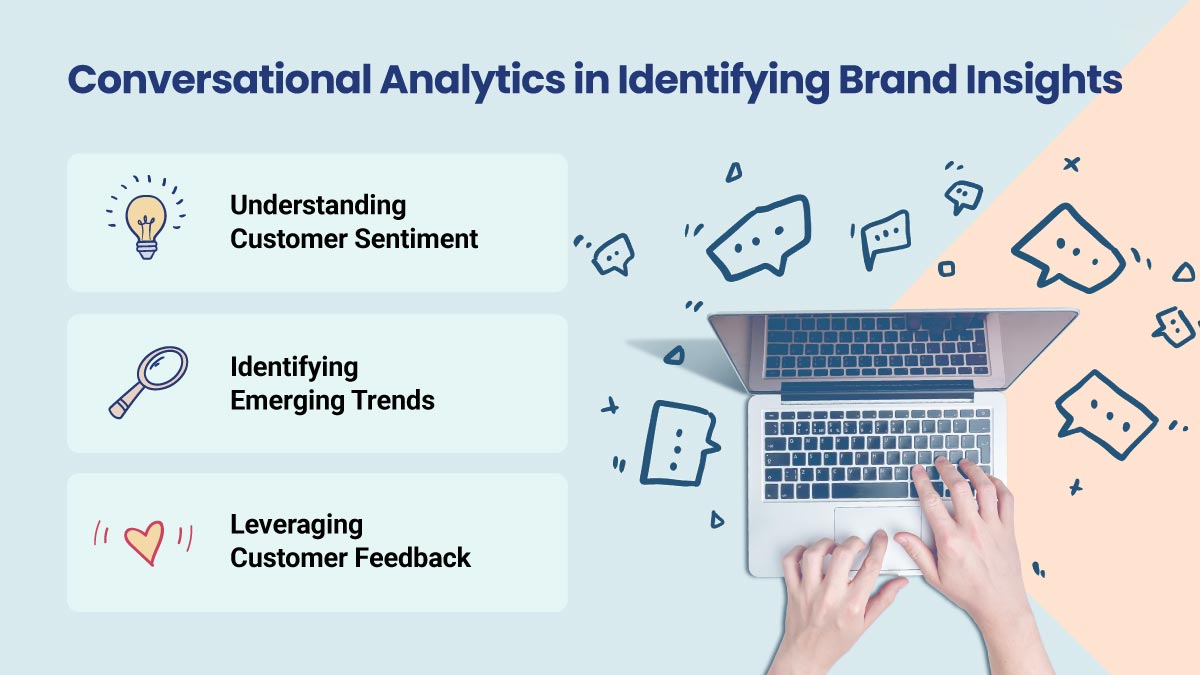
Gaining Competitive Intelligence
Conversation analytics solutions analyze conversations’ content, sentiment, and context to uncover patterns and trends. By understanding customer preferences, pain points, and competitor mentions, you can identify areas for improvement and develop strategies to outperform your rivals.
Leveraging conversational analytics enables you to respond to market changes and enhance your competitive edge proactively. Furthermore, it empowers you to align their offerings with customer needs and improve sales conversions.
Improving Sales Conversions
Businesses can boost sales by leveraging conversational analytics to gain valuable insights into customer interactions and tailor their strategies accordingly.
By applying speech and text analysis, you can extract meaningful information from these conversations. This data is crucial when identifying patterns, optimizing sales processes, and personalizing customer interactions. With conversational AI, you can automate follow-ups and provide real-time recommendations, enhancing the overall customer experience.
Tracking and Managing Brand Health
Effective brand tracking and management involves gaining insights into customer perceptions of the brand and ensuring alignment with the company’s strategic goals. Conversational analytics is crucial in tracking and managing brand health by analyzing customer interactions, feedback, and sentiments across various channels such as social media, customer support conversations, and online reviews.
This way, you can identify trends, measure brand sentiment, and track the impact of marketing campaigns on customer perception. This data-driven approach enables you to make informed decisions that impact how customers perceive your brand.
Understanding the importance of tracking and managing brand health, let’s now explore the various use cases of conversational analytics.
Use Cases of Conversational Analytics
One of the critical use cases of conversational analytics is analyzing customer feedback to improve product quality and performance. With the help of conversation analytics technology and conversational analytics software, you can perform:
Sentiment Analysis
Conversational analytics can analyze customer feedback and sentiment to understand how customers feel about a product or service. This information can help you make necessary adjustments to your offerings.
Competitive Analysis
Analyzing customer conversations, you can gain insights into how their products or services compare to competitors. This can help identify market gaps and develop strategies to stay ahead.
Voice of the Customer Analysis
Conversational analytics can help you embed the Voice of the Customer into your business. This information can be used to tailor products and services to meet customer expectations better and create a customer-centric organization.
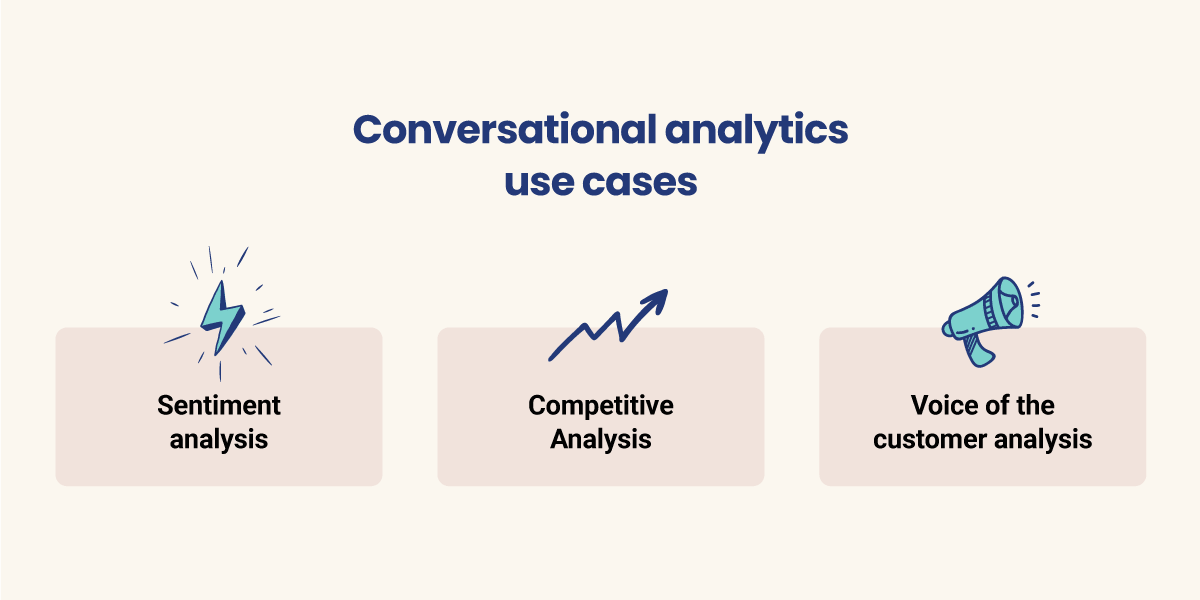
Optimizing Customer Service
The key to optimizing customer service lies in providing timely and personalized assistance. Conversational analytics can play a crucial role in achieving this goal. Contact centers can analyze customer interactions across various channels, such as phone calls, emails, and chat logs, to gain valuable insights by leveraging conversation intelligence. These insights can help identify customer pain points, improve agent performance, and enhance customer experience.
Conversational analysis insights can not only help your efforts to deliver proactive support but also, preemptively anticipate customer problems and prevent them from ever arising.
Additionally, chatbots powered by conversational analytics can provide immediate and consistent support, reducing customer wait times and increasing satisfaction while boosting customer service performance and reducing support costs.
Personalizing Customer Experience
To truly enhance satisfaction, you must strive to deliver personalized experiences consistently. Personalizing the customer experience is crucial for building stronger customer relationships and increasing loyalty.
By using conversational analytics, businesses can gain valuable insights into customer preferences, needs, and behaviors. This information can then tailor interactions and provide better customer experiences that resonate with customers.
Product Innovation
Product innovation is the lifeblood of business growth in today’s competitive market. By harnessing the power of real-time customer feedback, conversational analytics, and market trend identification, businesses can drive innovation, stay ahead of the competition, and meet evolving customer needs. Let’s explore how these topics shape product innovation.
Real-time Customer Feedback
Conversational analytics software allows you to analyze customer conversations in real-time, providing valuable insights that can be used to identify areas for product improvement and innovation.
Identifying Market Trends
Businesses can gain insights into emerging market trends, and customer demands to guide product development strategies and stay ahead of the competition.
Enhancing Conversation Intelligence
Conversational analytics enables businesses to understand customer sentiment, emotions, and intentions during conversations. This more profound understanding of customer needs and desires can inform product innovation, ensuring you develop products that genuinely solve customer problems and simplify their everyday lives.
The Future of Conversational Analytics
As technology advances at an unprecedented pace, the future of conversational analytics becomes increasingly exciting and filled with possibilities. The potential for even more sophisticated and accurate insights is just on the horizon, waiting to be harnessed by businesses and individuals alike.
We can expect three key developments to shape the landscape of conversational analytics in the coming years. These developments will enhance our understanding of customer behavior and preferences and pave the way for more personalized and targeted interactions. Let’s have a look at them!
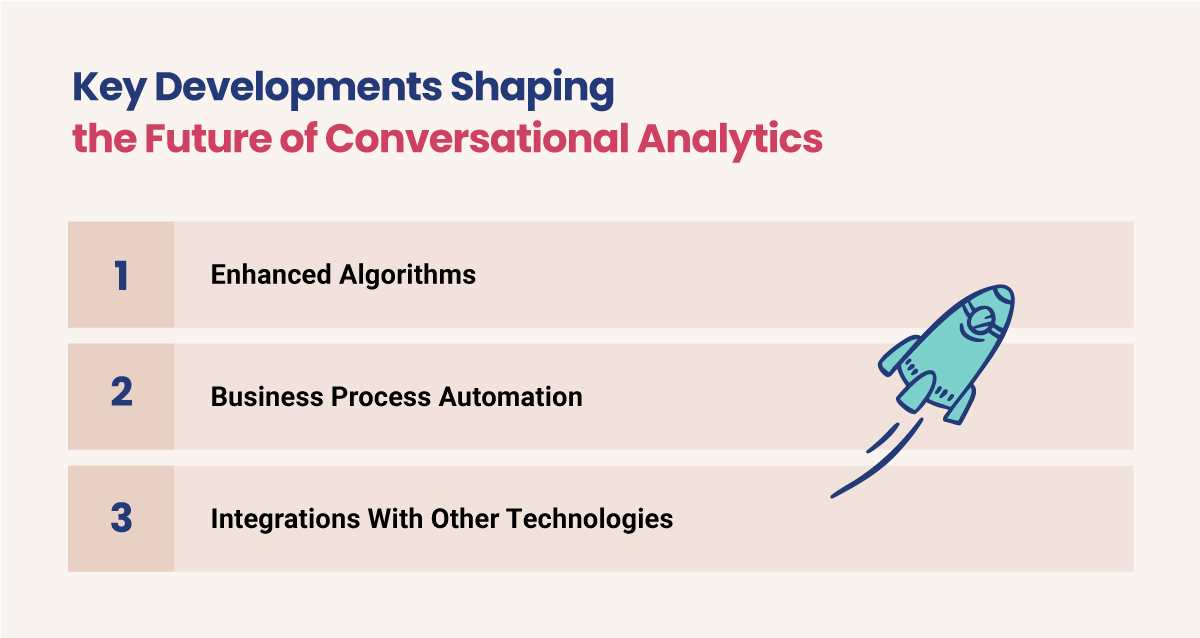
Enhanced Algorithms
The future of conversational analytics will see the development of more advanced algorithms that can analyze and interpret complex conversations in real time. These algorithms can extract deeper insights from conversations.
Business Process Automation
With the help of artificial intelligence (AI), conversational analytics will become a powerful tool for automating various business processes. AI-powered chatbots and virtual assistants can handle customer queries, gather data, and provide personalized recommendations while continuously learning and improving.
Integrations with Other Technologies
Conversational analytics will increasingly integrate with other technologies, such as natural language processing and machine learning. This integration will enable businesses to gain deeper insights from unstructured data, automate repetitive tasks, and enhance customer experiences.
Wrapping Up
In conclusion, conversational analytics can significantly benefit businesses by providing valuable insights and streamlining processes. It captures and analyzes data from various communication channels, such as phone calls, emails, and chat conversations. This data is then processed using advanced algorithms and natural language processing techniques to extract essential information and identify patterns and trends.
By analyzing customer interactions, conversation analytics can help businesses understand customer needs and preferences, identify areas for improvement, and optimize customer service strategies. Furthermore, analytics enables enterprises to track and measure key performance indicators, such as customer satisfaction and response times, to ensure continuous improvement.
Ultimately, conversation analytics empowers businesses to make informed, data-driven decisions, enhancing customer experiences by tailoring interactions to individual needs and preferences. This, in turn, paves the way for sustained business growth by fostering strong customer relationships and loyalty and allowing for the identification and capitalization of new opportunities in the evolving market landscape.
Remember, conversational analytics is your co-pilot in customer interactions, ensuring you’re always on the right path.
Happy data-driven decision-making!
Frequently Asked Questions
Did you like the post?
You might also like:

Surveypal
Everything you need to lead and improve your customer experience. Learn more at surveypal.com, or







